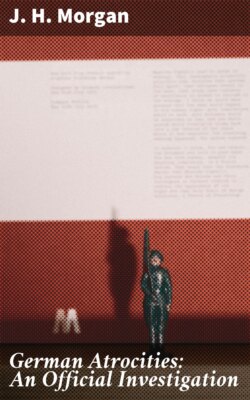German Atrocities: An Official Investigation

Реклама. ООО «ЛитРес», ИНН: 7719571260.
Оглавление
J. H. Morgan. German Atrocities: An Official Investigation
German Atrocities: An Official Investigation
Table of Contents
PREFATORY NOTE
Chapter I. INTRODUCTORY
I. THE BRITISH ENQUIRY
II. THE GERMAN CASE—A CRITICAL ANALYSIS OF THE GERMAN WHITE BOOK
German Invocation of The Hague Conventions
Charges against the Belgian Government
Belgian “Atrocities.”
The Massacres—Andenne
Jamoigne and Tintigny
The Tragedy of Dinant
“We gave them coffee.”
The Children were “quite happy.”
Aerschot
Louvain
A “murderous” attack; German casualties—five
Contradictory witnesses
The Priests
What is the true explanation?
III. GERMAN CREDIBILITY—A REVIEW OF THE EVIDENCE
The German Diaries
German Credibility
The Guilt of the German People
New Russian Evidence
The German Ideal—Europe in Chains
A Moral Distemper
IV. THE FUTURE OF INTERNATIONAL LAW AND THE QUESTION OF RETRIBUTION
The Dissolution of Europe
The Casuistry of the Intellectual Savage
Germany as a Moral Pervert
The Bankruptcy of The Hague Conventions
The Effect on International Law
The German as Outlaw
Conclusion
Chapter II. THE BRITISH ENQUIRY IN FRANCE
Methods of Enquiry
Outrages upon Combatants in the Field
The Proofs of Policy
Treatment of Civil Population
Outrages upon Women—The German Occupation of Bailleul
Private Property
Observations on a Tour of the Marne and the Aisne
Bestiality of German Officers and Men
Conclusion
Chapter III. DOCUMENTARY. I
(1)
(2)
(3)
(4)
(5)
(6)
(7)
(8)
(9)
(10)
(11)
(12)
(13)
(14)
(15)
(16)
(17)
(18)
(19)
(20)
(21)
(22)
(23)
(24)
(25)
(26)
(27)
(28)
(29)
(30)
(31)
(32)
(33)
(34)
(35)
(36)
(37)
(38)
(39, 40 and 41)
(42 and 43)
(44)
(45)
(46)
(47)
(48)
(49)
(50)
(51)
(52)
(53)
(54)
(55)
(56)
II. DOCUMENTS RELATIVE TO THE GERMAN OCCUPATION OF BAILLEUL93 République Française VILLE DE BAILLEUL, COMMISSARIAT DE POLICE
(1) Procès-Verbal No. 2. Meurtre de trois civils non combattants par des soldats allemands
(2) Procès-Verbal No. 1. Meurtre du jeune B——, Albert, par soldats allemands
Procès-Verbal, No. 3.—Meurtre des nommés Itsweire Donat, et Torrez Edouard, par une patrouille allemande
Procès-Verbal No. 4. Viol de la demoiselle D——, Marie Thérèse, par deux officiers allemands (4)
III. EVIDENCE RELATING TO THE MURDER OF ELEVEN CIVILIANS AT DOULIEU. Gendarmerie Nationale
IV. DEPOSITION OF A SURVIVOR OF THE MASSACRE OF TAMINES. Traduction de la déclaration faite en flamand par V—— A—— F——, mineur à TaminesParquet du Tribunal de 1re Instance d’Ypres Pro Justicia
V. FIVE GERMAN DIARIES
Extrait du Bulletin de Renseignements de la VIº Armée du 30 avril, 1915
VI
I. Violation of a Sister of Mercy
II. Violation of a Girl
III. Murder of Wounded Soldiers
IV. Murder of Wounded Soldiers
V. Murder of Wounded Soldiers
VI. Burning the Russian Wounded. Evidence of the Private Nicholas Semenov Dorozhka
VII. Ill-Treatment of Prisoners of War
VIII
IX
VII. THE GERMAN WHITE BOOK
The Introductory Memorandum
VIII. MASSACRE OF BRITISH PRISONERS BY GERMAN SOLDIERS AT HAISNES ON SEPTEMBER 25TH, 1915
IX. REPORTS RELATIVE TO THE USE OF INCENDIARY BULLETS BY GERMAN TROOPS96
Use of Incendiary Bullets by the Enemy
X
A FRESH EXAMINATION OF GERMAN WAR METHODS99
Footnote
Отрывок из книги
J. H. Morgan
Published by Good Press, 2021
.....
I turn to the case of Dinant, one of the most appalling massacres that have ever been perpetrated,28 even by the hordes of Kultur. No attempt is made to deny the wholesale slaughter; it is freely admitted, and with sanguinary iteration we are told again and again “a fairly large number of persons were shot, “all the male hostages assembled against the garden wall were shot.” Such battues occur on page after page.29 What is the German excuse? It is that the civilian population offered a desperate resistance. To prove how desperate it was, and consequently to establish the “military necessity,” it has to be conceded that they were organised. But this is proving too much, for “organised” civilian combatants are entitled to the privileges of lawful belligerents. Therefore it is argued that they were “without military badges”: this phrase occurs with a curious lack of variation in the words of each witness. It is added that women and “children (including girls) of ten or twelve years” were armed with revolvers! “Elderly women,” “a white-haired old man,” fired with insensate fury. None the less—says one ingenuous German witness—“the people had all got a very high opinion of Germany.” At intervals during the engagement not only were groups of civilians, alleged to have arms in their hands, shot in groups, but unarmed civilians were shot—“all the male hostages.” In other words the whole of the German defence that the German troops were punishing illicit francs-tireurs is suddenly abandoned. Tiring apparently of these laboured inventions, the German staff, in a grim and sombre sentence, suddenly throws off the mask:
“In judging the attitude which the troops of the 12th Corps took against such a population, our starting point must be that the tactical object of the 12th Corps was to cross the Meuse with speed, and to drive the enemy from the left bank of the Meuse; speedily to overcome the opposition of the inhabitants who were working in direct opposition to this was to be striven for in every way.... Hostages were shot at various places and this procedure is amply justified.”30
.....